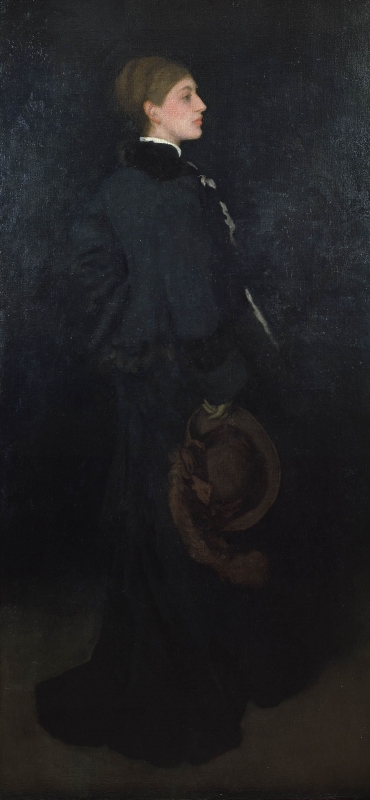Arrangement in Brown and Black: Portrait of Miss Rosa Corder may have been started in 1876, but extant records of sittings date from 1878. 1
1876/1878: Many years later, Whistler said that the portrait was commissioned by Charles Augustus Howell (1840?-1890), London, for £100, and Howell had said he would arrange with the London print-sellers, H. Graves & Co., for an engraving of it to be published, from which Whistler expected further payment. 2
1878: Thomas Robert Way (1861-1913) wrote that he saw it in Whistler's house in May/June 1878. 3 On 1 September 1878 Whistler wrote to Rosa Frances Corder (1853-1893) asking her for a sitting next day,
'I want to thank you for your kind endurance - but will do this best by finishing the picture troublesome as it still may be - After all the work is complete and an hour or two longer or less will entirely end the matter - I am charmed myself and one of these days you will forgive me -
Perhaps if you were to come tomorrow at about 3. or half past -
I do hope you are not too worn out.' 4
The tenancy of Whistler's studio in 96 Cheyne Walk had been taken by Sydney Morse (1854-1929) but he let Whistler stay on to complete some paintings, probably including that of Rosa Corder. On 3 September Whistler wrote asking Morse for a little more time:
'My pictures are about finished thanks to your patience - and I will go out at once - though if you could still spare me the room for this week I should be so awfully obliged -
... One of my portraits has been very greatly hindered by absence - and I could I believe obtain another couple of sittings, on Friday and Saturday next.' 5
Howell had at some time suggested: 'Arrange also for completing Rosie's portrait now that you are slack & I will go on forking out various.' ('Various' means, in this case, money). 6 On 5 September Whistler wrote inviting Howell to the studio, explaining 'I have written to Miss Corder that she is to pose again tomorrow as upon reflection I feel that the picture ought to be finished right out of hand.' 7
Four days later Algernon Graves (1845-1922) asked Whistler to send 'the portrait of Miss Corder' from 96 Cheyne Walk to his premises at 6 Pall Mall. 8
Théodore Duret (1838-1927) thought it was painted at the same time as Arrangement in White and Black [YMSM 185], which is not all that much help. 9
It was more or less completed in 1878, and by 1 January 1879, a subscription form had been prepared for a mezzotint engraving of the completed portrait by Richard Josey (1840-1906). 10
1903: According to the Pennells, Whistler took it to his studio for a few days after it was bought by Richard Albert Canfield (1855-1914), and washed it, 'for it was very dirty', worked on it, 'but very little', and had it varnished. 11
Notes:
1: YMSM 1980 [more] (cat. no. 203). Whistler's biographers, the Pennells, imply that it was started in 1876: Pennell 1908 [more] , vol. 1, pp. 201-22.
2: Whistler, 26 June 1900, quoted in Pennell 1921C [more] , pp. 60-61, 70, 276-80.
3: Way 1912 [more] , pp. 13, 25.
4: [1 September 1878], GUW #10040.
5: [3 September 1878], GUW #10875.
7: [5 September 1878], GUW #02790.
8: 9 September 1878, GUW #01797.
10: Subscription form for mezzotint, proof, 1 January 1879, GUW #08868; final version of circular, 7/31 August 1879, in GUL MS Whistler LB 11/71, GUW #11682.
Last updated: 22nd April 2021 by Margaret






